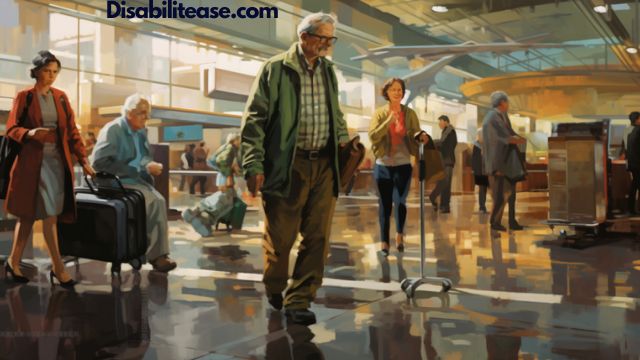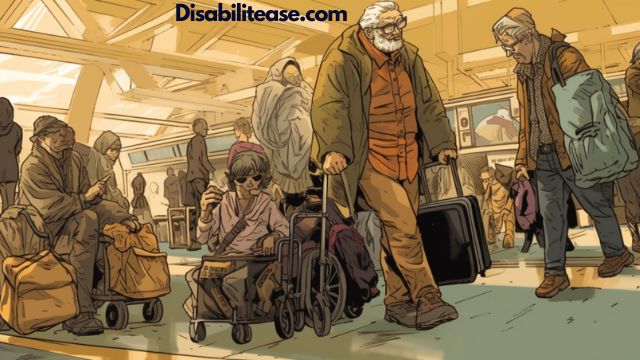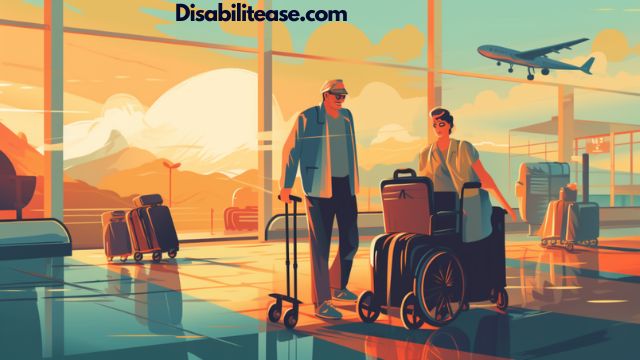Traveling can be a daunting experience, especially if you’re disabled or elderly. Navigating airports with special needs can seem overwhelming. But don’t worry, there are plenty of ways to make your journey easier and smoother!
In this article we’ll provide some essential tips on how to navigate airports as a disabled or elderly traveler.
You’ll learn about pre-trip planning, airport assistance services, security screenings, in-terminal services and post-trip considerations.
So read on and let’s get started!

Table of Contents
Tips for Navigating Airports As A Disabled Or Elderly Traveler
Here are some things to consider when planning to visit the airport if you’re disabled or an elderly traveler:
Pre-Trip Planning
Pre-trip planning is key for disabled and elderly travelers, so make sure you take a few moments to plan your journey before heading to the airport! Prioritizing your needs and planning ahead will help ensure that navigating airports is smooth and stress-free.
Make sure you research the specific airport you’re visiting beforehand, as different airports have different layouts and services. Check whether any of the airport’s services are tailored specifically for disabled or elderly customers, such as special assistance desks or wheelchair rental services.
It’s also useful to contact the airline prior to your flight in order to make them aware of your specific needs; this can help avoid any complications at the check-in desk or when boarding.
Taking some time to plan before setting off can make all the difference when it comes to navigating airports as a disabled or elderly traveler.
Airport Assistance Services

To ensure a stress-free journey, you may wish to avail yourself of the airport assistance services available for those with special needs.
Most airports offer navigation aids to help travelers reach their gate or connecting flights. This can include textured flooring and tactile maps which provide additional guidance to those who are visually impaired or elderly.
Additionally, many airlines have policies in place that make it easier for travelers with disabilities or mobility issues. This could include priority seating during boarding, access to wheelchairs and other assistive devices, as well as complimentary check-ins and baggage handling services.
Be sure to discuss your specific needs with airline personnel prior to your departure so they can provide the best possible assistance when you travel.
Security Screenings
Navigating airport security screenings can be a daunting experience for disabled or elderly travelers. Thankfully, many airports and the TSA have implemented pre-screening programs to make the process more straightforward.
In addition, the TSA Cares Program provides assistance with communication, screening processes, and other services to ensure that disabled or elderly travelers are comfortable at every step of their journey.
Pre-Screening Programs
Cruising through the airport without stopping or waiting can be a reality with pre-screening programs. As a disabled or elderly traveler, you have the right to pre-screening that allows for faster passage through security checkpoints.
Pre-screening programs are designed to allow travelers with special needs equipment, such as wheelchairs and crutches, to move quickly and safely through security checkpoints. The Transportation Security Administration (TSA) has established special lanes for those enrolled in these programs, enabling them to more easily navigate airports.
Depending on your airline and airport of choice, you may need to register ahead of time for the program in order to take advantage of it when traveling.
Some airlines also offer specific services for disabled and elderly passengers that allow them access to areas not available to other travelers; so make sure you contact your airline before your trip in order to find out what benefits are offered.
TSA Cares Program
The TSA Cares program offers those with special needs the opportunity to enjoy a more seamless experience at the airport. It provides a variety of services, such as:
- Pre-travel notification so wheelchair transportation can be arranged
- Assigned security screening lane, if needed
- Access to communication devices for nonverbal travelers
These services make it easier for disabled and elderly travelers to feel comfortable and secure during their trip. Plus, they’re free of charge! Travelers simply have to call ahead 72 hours in advance so that special arrangements can be made prior to their arrival at the airport.
This proactive approach ensures that everyone has an enjoyable journey.
In-Terminal Services

Once you arrive at the airport, there are a variety of in-terminal services available to make your experience easier.
Accessible restrooms are located throughout the terminal for those with physical or medical needs, and special assistance areas provide further support.
If you require medical help during your stay, airport staff can assist with that as well.
Accessible Restrooms
Accessible restrooms are a must when traveling as a disabled or elderly person, so make sure you have the information you need before leaving home!
Most airports offer accessible restrooms that have wheelchair access and can accommodate larger mobility aids. This makes it easier for those with special needs to use the restroom without having to worry about struggling with doors or other obstacles.
To ensure that an airport’s restrooms are accessible, it is important to check ahead of time which ones provide this service. A simple online search can help find out what facilities each airport offers, such as:
| Facilities | Availability |
|---|---|
| Wheelchair Access | Yes/No |
| Mobility Aids | Yes/No |
Special Assistance Areas
Navigating airports with special needs can be made easier by taking advantage of the designated assistance areas found in many airports. These areas are set up to provide passengers with special needs, such as elderly or disabled travelers, access to help and resources.
Most airports have a central location where you can find information about their accessibility rules, get assistance with boarding requirements, and request any type of special needs assistance.
Many airports also offer wheelchairs for rent so that those who need them can easily get around the airport on their own. The staff in these areas are there to help make your travel experience more comfortable and stress-free.
If you’re an elderly or disabled traveler, it’s important to take advantage of the services available at these special assistance areas.
They will provide you with any information or support you need while navigating through the airport and will ensure that your trip is safe and enjoyable.
Whether you require wheelchair rental or just some extra help getting around, these areas are designed to make traveling easier for all passengers regardless of age or disability.
Medical Assistance
If you’re a disabled or elderly traveler needing medical assistance while navigating the airport, there are resources available to make your trip easier.
Most airports offer special medical services such as wheelchair access and the accommodation of medical equipment. This can be especially helpful for travelers with limited mobility who may need additional assistance getting around the airport.
For those needing more specialized help, many airports also have on-site medical personnel or dedicated areas where passengers can get medical attention if needed. From providing oxygen tanks to administering injections, these staff members are available to provide safe and efficient care.
So, no matter what type of help you need to make your journey smoother, rest assured that the appropriate resources will be available at most airports.
Post-Trip Considerations
Once you’ve navigated an airport as a disabled or elderly traveler, it’s important to consider post-trip factors that can make future trips easier. Review your experience and plan for the next journey to make your travels less stressful. Here are some things to keep in mind:
- Log all transportation options that work for you, from accessible parking, shuttles, and public transit systems, to wheelchairs and carts, so you’ll know what will be available when you return.
- Note any areas of the terminal or airport facility that prove difficult for navigation. This will help you plan how best to move through the space next time.
- Look into special services offered by airports like curbside check-in, wheelchair assistance programs, and more. Knowing these are available can make your travel much simpler down the road.
- Make sure to gather contact information for relevant personnel who may be able to assist with future trips, such as airline customer service departments and disability services representatives at each airport.
- Finally, if possible, take photos of any signage or markings that indicate where disabled/elderly travelers should go in airports. Having visuals makes it easy to remember which path works best for you!
Conclusion
Planning ahead and taking advantage of airport services can make navigating airports as a disabled or elderly traveler easier. Before your trip, do your research and find out what’s available to you.
That way, you won’t be overwhelmed when the time comes. You don’t have to go it alone; take advantage of the help that’s available to you so that your journey is as stress-free as possible.
With a little preparation, you can navigate airports with confidence and ease.

Hi, my name is Eddie, I am a professional trainer specializing in the elderly population and I’m also a website designer. I love training in the gym, going to the beach, traveling, and having good food.
I combined my love for sport and website designing to make “DisabilitEase” whose purpose is to help elderly and disabled people live a more full and active life, have more fun, and enjoy their unique journey despite any disability.


